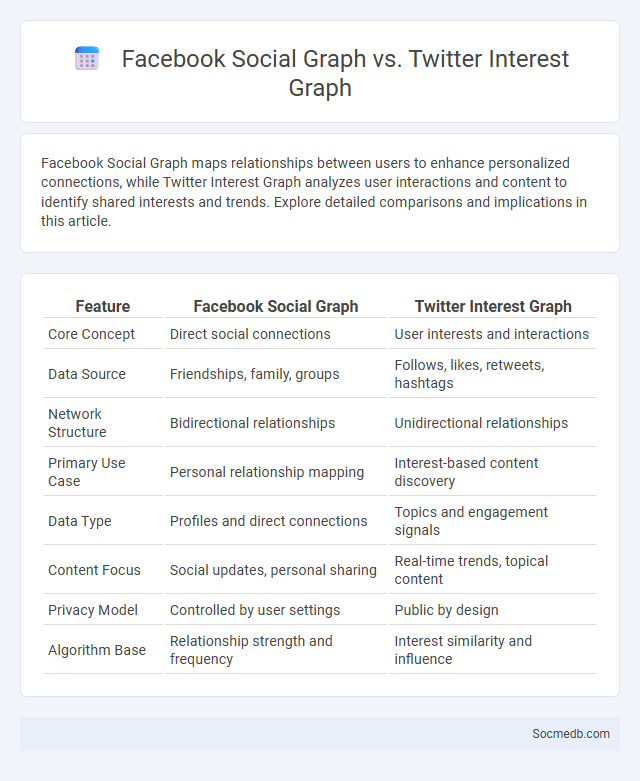
Photo illustration: Facebook Social Graph vs Twitter Interest Graph
Facebook Social Graph maps relationships between users to enhance personalized connections, while Twitter Interest Graph analyzes user interactions and content to identify shared interests and trends. Explore detailed comparisons and implications in this article.
Table of Comparison
| Feature | Facebook Social Graph | Twitter Interest Graph |
|---|---|---|
| Core Concept | Direct social connections | User interests and interactions |
| Data Source | Friendships, family, groups | Follows, likes, retweets, hashtags |
| Network Structure | Bidirectional relationships | Unidirectional relationships |
| Primary Use Case | Personal relationship mapping | Interest-based content discovery |
| Data Type | Profiles and direct connections | Topics and engagement signals |
| Content Focus | Social updates, personal sharing | Real-time trends, topical content |
| Privacy Model | Controlled by user settings | Public by design |
| Algorithm Base | Relationship strength and frequency | Interest similarity and influence |
Introduction to Social and Interest Graphs
Social and interest graphs represent the intricate networks connecting individuals based on their relationships, interactions, and shared interests across social media platforms. These graphs help analyze your online behavior, preferences, and connections to deliver personalized content, enhance engagement, and improve recommendation algorithms. Leveraging social and interest graphs enables businesses to target audiences more effectively and foster stronger community connections.
Understanding Facebook’s Social Graph
Facebook's Social Graph maps the relationships between users, pages, and content to personalize your experience and enhance connectivity. By leveraging data on friendships, likes, and interactions, the Social Graph enables targeted advertising and relevant content delivery. Understanding this network helps you optimize privacy settings and engage meaningfully within your digital community.
Exploring Twitter’s Interest Graph
Twitter's Interest Graph maps Your connections, revealing nuanced interests through user interactions, follows, and content engagement. This real-time data helps brands and individuals tailor content strategies by targeting specific communities and trending topics. Leveraging Twitter's Interest Graph enhances audience insights, driving more relevant and personalized social media experiences.
Key Differences Between Social Graph and Interest Graph
Social graph maps the relationships and connections between individuals, emphasizing how you interact with friends, family, and colleagues on social media platforms. Interest graph, in contrast, organizes users based on shared interests and preferences, connecting people who engage with similar content regardless of their personal relationships. Understanding these differences helps you tailor your social media strategy to leverage either personal networks or common interests for maximum engagement.
User Connections: Friends vs Followers
User connections on social media differ primarily between friends and followers, where friends typically represent mutual, two-way relationships often requiring approval, fostering closer interactions and shared privacy. Followers enable one-way connections, allowing users to broadcast content to a wider audience without reciprocal engagement, ideal for influencers and public figures. Platforms like Facebook emphasize friends for personal networking, while Twitter and Instagram highlight followers to maximize reach and content dissemination.
Data Structure and Network Mapping
Social media platforms rely heavily on advanced data structures like graphs and trees to efficiently organize and retrieve vast amounts of user-generated content. Network mapping plays a crucial role in analyzing connections between users, identifying clusters, and detecting influential nodes within a social graph. By understanding these structures, you can optimize user engagement and enhance targeted content delivery.
Impacts on Content Discovery and Recommendations
Social media platforms harness advanced algorithms to analyze Your interactions, enabling personalized content discovery that aligns with Your interests and behaviors. These recommendation systems continuously evolve by processing vast amounts of user data, which enhances the relevancy and engagement of suggested posts, videos, or articles. As a result, social media significantly influences how users encounter and consume information, shaping their digital experience through tailored content streams.
Privacy and Data Sharing Concerns
Social media platforms collect vast amounts of personal information, raising significant privacy and data sharing concerns among users worldwide. Data breaches and unauthorized sharing of sensitive information with third parties threaten user security and erode trust in these digital networks. Enhanced privacy settings, transparent policies, and stringent regulatory measures are critical to safeguarding user data and ensuring responsible data management practices.
Marketing and Advertising Implications
Social media platforms offer unparalleled targeting capabilities for marketing and advertising, leveraging user data to deliver personalized content and maximize campaign ROI. Businesses harness influencer partnerships and viral content strategies to enhance brand visibility and consumer engagement across channels such as Facebook, Instagram, and TikTok. Real-time analytics enable marketers to optimize ad performance and adapt messaging, driving higher conversion rates and customer loyalty.
Future Trends: Evolving Social and Interest Graphs
Future trends in social media highlight the evolution of social and interest graphs, enabling platforms to deliver hyper-personalized content by analyzing complex user relationships and preferences. Advanced AI algorithms will enhance the mapping of social connections and niche interests, driving more relevant recommendations and fostering deeper community engagement. This shift will empower brands and creators to target audiences with precision, optimizing user experience and monetization strategies.
 socmedb.com
socmedb.com